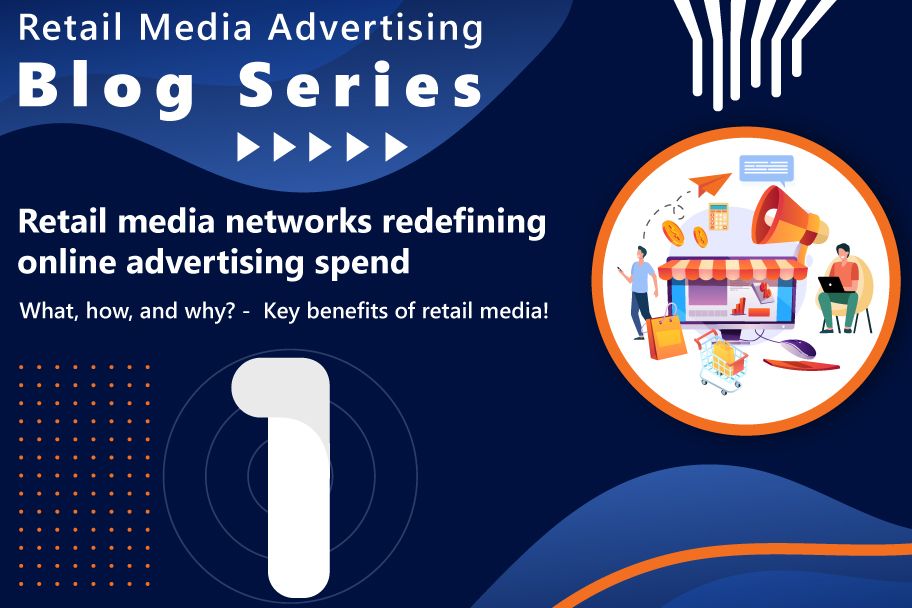What, how, and why? - Key benefits of retail media!
What is retail media advertising?
Any type of digital advertisement (text, display, video) placed on a retailer’s e-commerce platform or displayed as a response to a search is termed as retail media advertisement. The intent is to mimic the front of the aisle concept online to target users/buyers who visit e-commerce platforms and enable sales closures by placing relevant product ads at various entry and exit points. While most of the ads are placed by retailers to sell their products, these platforms also greatly benefit brands' awareness/recall to reach a wider consumer base with buying intent in one place.
Retail consumers buying process
Why is retail media important of late?
The e-commerce industry’s growth has been exponential since 2014 and is expected to reach $7.391 billion by 2025. The recent pandemic events of 2019 have redefined the buying pattern and the customers’ shopping behavior has become more digital - the number of online shoppers in the US alone has grown to 230.5 million by 2021.
This has forced retailers to shift their strategies toward enabling digital marketing & ads avenues for brands and CPGs by building advertising platforms like what Google, Facebook, or LinkedIn have done, The retailers have an advantage to target customers based on the available first-party & demographical data and purchasing behavior at the different stages of the buying process.
How does retail media work?
There are two ways in which a retail media network enables to drive sales for its brand and in turn revenue for itself.
Firstly, if you are a retail outlet with high web traffic then you can set up your retail media network allowing brands to place ads on your e-commerce platforms to sell their products/services, by this way an additional revenue stream is created. This could be via managed services and/or self-services. Some of the early adopters like Amazon have built their platforms - Amazon Advertising, likewise Walmart Connect for Walmart, Clubcard for Kroger, and Instacart are fast emerging options for the brands that follow both managed and self-service models.
Secondly, if you are a retail outlet and looking at selling the brand’s products/services by reaching a wider audience, then you can use the first-party data and buyer journey map to re-target ads on relevant programmatic and social networks through a managed service model to increase brand awareness and sales.
The market potential for retail media is still wide open for new entrants provided they can differentiate themselves in the following ways:
- A huge customer base is an obvious reason but having structured customer data and positive customer relationships will largely influence the media buyers in the long run. Small and Mid-size retailers must build better relationships with their existing online and offline customers and capture data before building the retail media network.
- New entrants should try building simpler user interfaces for the media buyers and provide faster training and collaboration for them to have a seamless user experience with the platform.
- Technologies like RPA and ML/AI should be integrated throughout the ad operations process along with analytics tools to scale media planning, audience building, order management, ad serving, etc.
While we talk about retailers like Kroger, Walmart, BestBuy, etc. are climbing up the retail media market, there is still a large scope for other industries like Travel, Food, and Pharma which have a huge offline and online customer base and yet in the process of achieving the success that of the Amazons and the Walmart’s of the world.
Benefits of retail media advertising
The benefits can be viewed from three perspectives,
- Through retail media networks, the large retail players can generate additional revenue and provide a better buying experience to their customers by showing relevant ads and empowering them with relevant sources of information like ratings and reviews.
- The retailers can now reach customers at a closer point of sales by placing shoppable ads on an e-commerce platform. These retail media ads are more likely to close a purchase while they are shopping online rather than browsing on google search or reading online news. With customers’ 1st party data, the level of targeting, attribution, and return on ad spend (ROAS) is relatively better when compared to any other platforms.
- When the ads are relevant to the consumers based on their interests and purchasing behavior, it provides a better shopping experience with better search results and product-based ads, enabling customers to make better and faster purchase decisions.
Retail Media - The way forward:
There is enough data available to quantify that retail media advertising is growing at a rapid pace and the early adopters have already gained a huge competitive advantage, if you are an online e-commerce retailer involved in any kind of B2C business then either you can be on one side building your retail media network to place ads on your platform to generate additional revenue, sales stickiness and empower customers with variety products/services or make use of the large relevant programmatic networks to reach your target audience who are at the various stages of the buying process.
Integrated Customer relationships, Media buying experience, customer support, and Tools & Technologies for reporting and analytics will play a prominent role in building an efficient retail media network. At iOPEX deep thoughts, you can find other blogs related to retail media below and if you will need more information about our personalized offerings, reach out to [email protected] or contact us
Read the next blog from the series











